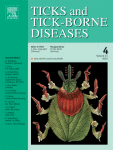View Item
- xmlui.general.dspace_homeCentros Regionales y EEAsCentro Regional Santa FeEEA RafaelaArtículos científicosxmlui.ArtifactBrowser.ItemViewer.trail
- DSpace Home
- Centros Regionales y EEAs
- Centro Regional Santa Fe
- EEA Rafaela
- Artículos científicos
- View Item
Ornithodoros cerradoensis n. sp. (Acari: Argasidae), a member of the Ornithodoros talaje (Guérin-Méneville, 1849) group, parasite of rodents in the Brazilian Savannah
Abstract
Ornithodoros cerradoensis n. sp. is described from field-collected and laboratory reared nymphs, males, females, and larvae parasitizing the rodents Cavia aperea and Thrichomys sp. in the Brazilian Savannah. This new species is morphologically and genetically related with the Ornithodoros talaje group and can be separated from other Neotropical species using the following combination of characters: larva with 18 pairs of setae on dorsum (seven
[ver mas...]
Ornithodoros cerradoensis n. sp. is described from field-collected and laboratory reared nymphs, males, females, and larvae parasitizing the rodents Cavia aperea and Thrichomys sp. in the Brazilian Savannah. This new species is morphologically and genetically related with the Ornithodoros talaje group and can be separated from other Neotropical species using the following combination of characters: larva with 18 pairs of setae on dorsum (seven anterolateral, four central and seven posterolateral), hypostome with median dentition 2/2; adults provided with large mammillae; dorsal disks surrounded by bulked marginal ridges delimiting barely pebbled areas; three disks in the anterolateral file, and median disk not merging with the posteromedian file. Feeding assays in the laboratory demonstrated that (1) larvae of O. cerradoensis are slow-feeders (∼6 days), (2) first nymphal instar (N1) molts to second instar (N2) without feeding, and (3) N2 and third nymphal instar (N3) engorge rapidly (minutes). With the exception of Ornithodoros hasei nymphs that depict flattened bodies, O. cerradoensis N1, N2, and N3 highly resemble homologous instars of other species in O. talaje sensu lato, therefore are not suitable for morphological comparisons within the group. In addition to morphological signature of larvae and adults that separate this new species; results of cross-mating attempts between O. cerradoensis and Ornithodoros guaporensis a morphologically and phylogenetically closely related species that also parasitizes rodents in the Brazilian Savannah; a Principal Component Analysis using larval characters; and a phylogenetic analysis using mitochondrial markers, support O. cerradoensis as an independent lineage within the Ornithodorinae.
[Cerrar]

Author
Muñoz-Leal, Sebastian;
Martins, Maria Marlene;
Nava, Santiago;
Landulfo, Gabriel Alves Lves;
Simons, Simone Michaela;
Rodrigues, Vinícius Da Silva;
Ramos, Vanessa Do Nascimento;
Suzin, Adriane;
Szabó, Matías P.J.;
Labruna, Marcelo B.;
Fuente
Ticks and Tick-borne Diseases 11 (5) : 101497 (September 2020)
Date
2020-09
Editorial
Elsevier
ISSN
1877-959X
Formato
pdf
Tipo de documento
artículo
Palabras Claves
Derechos de acceso
Restringido
 Excepto donde se diga explicitamente, este item se publica bajo la siguiente descripción: Creative Commons Attribution-NonCommercial-ShareAlike 2.5 Unported (CC BY-NC-SA 2.5)
Excepto donde se diga explicitamente, este item se publica bajo la siguiente descripción: Creative Commons Attribution-NonCommercial-ShareAlike 2.5 Unported (CC BY-NC-SA 2.5)

